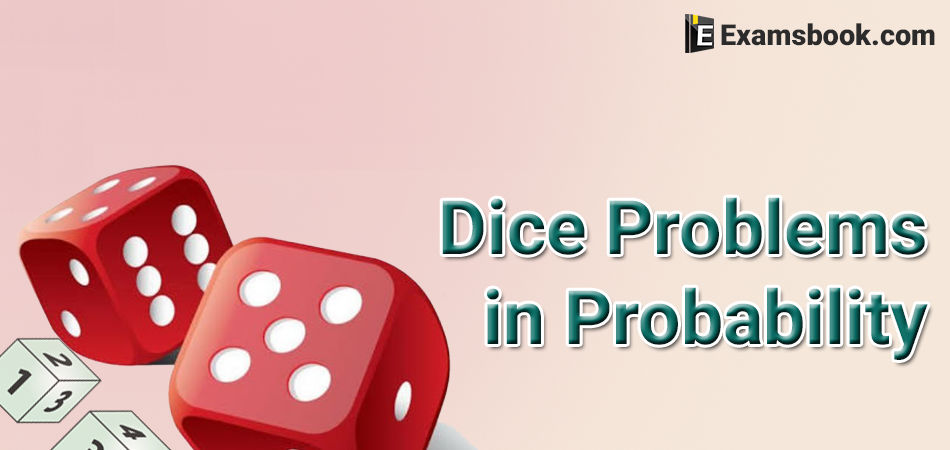Dice Problems in Probability for Competitive Exams

Dice Problems in Probability with Solutions
Direction (7-19): Two dice are thrown simultaneously. Find the probability of:
Q.7. Getting sum of at least 11
ans 1/12
(A) 1/11
(B) 1/10
(C) 1/9
(D) 1/12
Ans . D
Two different dice are thrown simultaneously being number 1, 2, 3, 4, 5 and 6 on their faces. We know that in a single thrown of two different dice, the total number of possible outcomes is (6 × 6) = 36
getting sum of atleast 11:
Let E7 = event of getting sum of atleast 11. The events of the sum of atleast 11 will be E7 = [(5, 6), (6, 5), (6, 6)] = 3
Therefore, probability of getting ‘sum of atleast 11’
$$P(E) ={Number \ of \ favorable \ outcomes\over Total \ number \ of \ possible \ outcome }$$
= 3/36
= 1/12
Q.8. Getting six as a product
(A) 1/9
(B) 1/8
(C) 1/6
(D) 1/10
Ans . A
Two different dice are thrown simultaneously being number 1, 2, 3, 4, 5 and 6 on their faces. We know that in a single thrown of two different dice, the total number of possible outcomes is (6 × 6) = 36
getting six as a product:
Let E1 = event of getting six as a product. The number whose product is six will be E1 = [(1, 6), (2, 3), (3, 2), (6, 1)] = 4
Therefore, probability of getting ‘six as a product’
$$P(E) ={Number \ of \ favorable \ outcomes\over Total \ number \ of \ possible \ outcome }$$
= 4/36
= 1/9
Q.9. Getting a multiple of 3 as the sum
(A) 1/2
(B) 1/8
(C) 1/3
(D) 2/9
Ans . C
Two different dice are thrown simultaneously being number 1, 2, 3, 4, 5 and 6 on their faces. We know that in a single thrown of two different dice, the total number of possible outcomes is (6 × 6) = 36
getting a multiple of 3 as the sum:
Let E8 = event of getting a multiple of 3 as the sum. The events of a multiple of 3 as the sum will be E8 = [(1, 2), (1, 5), (2, 1), (2, 4), (3, 3), (3, 6), (4, 2), (4, 5), (5, 1), (5, 4), (6, 3) (6, 6)] = 12
Therefore, probability of getting ‘a multiple of 3 as the sum’
$$P(E) ={Number \ of \ favorable \ outcomes\over Total \ number \ of \ possible \ outcome }$$
= 12/36
= 1/3
Q.10. getting sum ≤ 3
(A) 2/25
(B) 1/12
(C) 1/16
(D) 2/16
Ans . B
Two different dice are thrown simultaneously being number 1, 2, 3, 4, 5 and 6 on their faces. We know that in a single thrown of two different dice, the total number of possible outcomes is (6 × 6) = 36
getting sum ≤ 3:
Let E2 = event of getting sum ≤ 3. The number whose sum ≤ 3 will be E2 = [(1, 1), (1, 2), (2, 1)] = 3
Therefore, probability of getting ‘sum ≤ 3’
$$P(E) ={Number \ of \ favorable \ outcomes\over Total \ number \ of \ possible \ outcome }$$
= 3/36
= 1/12
Q.11. Getting a total of at least 10
(A) 1/6
(B) 5/8
(C) 7/9
(D) 1/10
Ans . A
Two different dice are thrown simultaneously being number 1, 2, 3, 4, 5 and 6 on their faces. We know that in a single thrown of two different dice, the total number of possible outcomes is (6 × 6) = 36
getting a total of atleast 10:
Let E9 = event of getting a total of atleast 10. The events of a total of atleast 10 will be E9 = [(4, 6), (5, 5), (5, 6), (6, 4), (6, 5), (6, 6)] = 6
Therefore, probability of getting ‘a total of atleast 10’
$$P(E) ={Number \ of \ favorable \ outcomes\over Total \ number \ of \ possible \ outcome }$$
= 6/36
= 1/6
Q.12. Getting sum ≤ 10
(A) 10/12
(B) 12/10
(C) 11/12
(D) 15/17
Ans . C
Two different dice are thrown simultaneously being number 1, 2, 3, 4, 5 and 6 on their faces. We know that in a single thrown of two different dice, the total number of possible outcomes is (6 × 6) = 36
getting sum ≤ 10:
Let E3 = event of getting sum ≤ 10. The number whose sum ≤ 10 will be E3=
[(1, 1), (1, 2), (1, 3), (1, 4), (1, 5), (1, 6),
(2, 1), (2, 2), (2, 3), (2, 4), (2, 5), (2, 6),
(3, 1), (3, 2), (3, 3), (3, 4), (3, 5), (3, 6),
(4, 1), (4, 2), (4, 3), (4, 4), (4, 5), (4, 6)
(5, 1), (5, 2), (5, 3), (5, 4), (5, 5),
(6, 1), (6, 2), (6, 3), (6, 4)] = 33
Therefore, probability of getting ‘sum ≤ 10’
$$P(E) ={Number \ of \ favorable \ outcomes\over Total \ number \ of \ possible \ outcome }$$
= 33/36
= 11/12
Feel free and ask me in the comment section related dice problems in probability if you face any problem. Visit to the next page for more practice.



